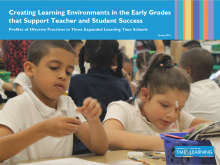New Report Explores Value of Expanded Learning Time for Students in the Early Grades
Submitted by David Farbman on
Creating Learning Environments in the Early Grades That Support Teacher and Student Success profiles three schools that have leveraged an expanded-day to foster a positive school culture, high expectations for all, and a well-rounded education.

